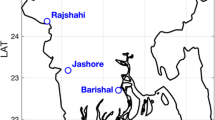Abstract
In Argentina, head blight or scab is a highly risky disease (caused by Fusarium graminearum) of wheat, although its occurrence is sporadic depending on prevalent environmental variables. These traits stimulated the development of predictive models of head blight epidemics, which would help growers in the selection of control strategies. Regression models for predicting head blight incidence were developed at Pergamino (33°56S, 60°30W), associating temperature and moisture variables with mean disease data (empirical approach). Recently a new fundamental-empirical approach for estimating Fusarium index (incidence%×severity%/100) was developed using data from Pergamino and Marcos Juarez (32°41′S, 62°07′W). Validation studies of both empirical and fundamental-empirical approaches were carried out at northern and southern locations showing good results after making a few changes. The objective of this work was to examine the goodness of fit of the predicted values from both approaches (original and including some of the changes derived from previous validation studies) in comparison with median disease data in two southern locations of the Pampas region: Balcarce (37°45′S, 58°18′W) and Barrow (38°19′S, 60°15′W), for the 2002, 2003 and 2004 wheat seasons. Partial and mean deviation values between observed and predicted data were calculated. In accordance with previous validation studies, successful Fusarium index estimations were achieved decreasing the heat accumulation defining the length of the wheat critical period for infection to 450 degree days [base mean daily temperature (Td)=10°C]. Reducing the critical period length [450 degree days (base Td=0°C) instead of 530] and increasing maximum and minimum temperature thresholds (30° instead of 26°C and 11°C instead of 9°C) of the empirical equation thermal variable led to satisfactory Fusarium incidence predictions. This study showed that both approaches developed at northern locations of the Pampas region can be portable and useful for predicting disease intensity at more southern locations, making only a few changes. Differences in wheat cultivar behaviour regarding the disease were observed in the analysed data but this effect was not considered in this study.
Similar content being viewed by others
References
Andersen AL (1948) The development of Gibberella zeae head blight of wheat. Phytopathology 38, 599–611.
Carranza MR, Lori GA, Sisterna MN (2002) Fusaria involved in the head blight complex of wheat in Argentina. Fitopatología 37, 164–168.
de Galich MTV, Galich AN (1994) Enfermedades del trigo en el área sur de Santa Fé y Córdoba. EEA Marcos Juárez. INTA Información para extensión No. 5. pp. 1–7.
Moschini RC, Carmona MA (1998) Fusariosis en trigo. Nuevo enfoque para su control en el área de Balcarce. Revista ALEA Informa Año 1(8), 16–20.
Moschini RC, Fortugno C (1996) Predicting wheat head blight incidence using models based on meteorological factors in Pergamino, Argentina. European Journal of Plant Pathology 102, 211–218. doi: 10.1007/BF01877959
Moschini RC, Pioli R, Carmona MA, Sacchi O (2001) Empirical predictions of wheat head blight in the northern Argentinean Pampas region. Crop Science 41, 1541–1545.
Moschini RC, de Galich MTV, Annone JG, Polidoro O (2002) Enfoque Fundamental-Empírico para estimar la evolución del Indice de Fusarium en trigo. Revista RIA 31, 39–53.
Moschini RC, Carranza MR, Carmona MA (2004) Meteorological-based predictions of wheat head blight epidemic in the southern argentinean The Netherlands) Pampas region. Cereal Research Communications 32, 45–52.
Author information
Authors and Affiliations
Corresponding author
Rights and permissions
About this article
Cite this article
Carranza, M.R., Moschini, R.C., Kraan, G. et al. Examination of meteorology-based predictions of Fusarium head blight of wheat grown at two locations in the southern Pampas region of Argentina. Australasian Plant Pathology 36, 305–308 (2007). https://doi.org/10.1071/AP07025
Received:
Accepted:
Issue Date:
DOI: https://doi.org/10.1071/AP07025




